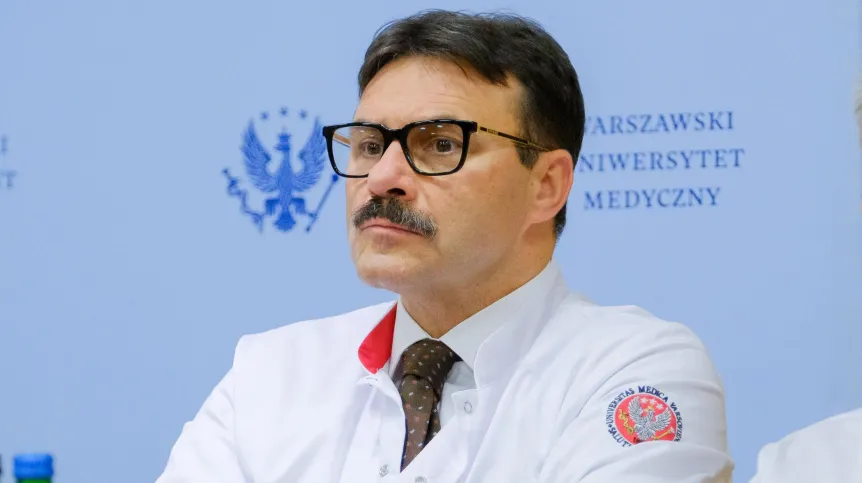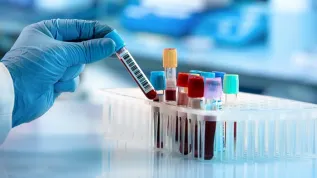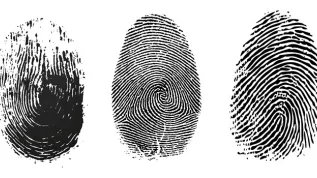
The first next-generation total artificial heart in Poland has been implanted by doctors from the Medical University of Warsaw. Although it has been improved, no machine can replace a living human heart, at least for now, says Professor Mariusz Kuśmierczyk, who performed the surgery.
Professor Kuśmierczyk is the head of the university’s Department of Heart, Thoracic and Transplant Surgery. He performs innovative heart surgeries and heart transplants in adults and children. Recently, he and his team performed three heart transplants on infants in just 1.5 months. He has performed simultaneous heart and liver and heart and kidney transplants.
PAP: For the first time in Poland, you implanted the next generation Total Artificial Heart (TAH) called Carmat. The recipient was a 37-year-old patient with severe failure of both ventricles and pulmonary hypertension. For this reason, he did not qualify for a live heart transplant or implantation of a circulatory pump. Now he has a new chance.
Prof. Mariusz Kuśmierczyk: This is currently the only total artificial heart available in Europe, developed in France. It was purchased thanks to the efforts of the Medical University of Warsaw. One of its main designers is the French heart surgeon Professor Alain Carpentier, who will soon turn 91. He has made a great contribution to our specialisation - in 2007 he received the Lasker Award for the development of mitral and aortic valve surgery. He was the first in the world to implant an artificial biological valve (in 1968). He is the inventor of the biological valves used in the Carmat artificial heart.
PAP: This is something new in Poland and another great achievement of Polish cardiac surgery - and you personally. But the Carmat TAH was first implanted in Paris more than 10 years ago. This implantation in Poland is the 58th in the world.
M.K.: Yes, it was certified and approved for use recently, in December 2023. Previously, it was used as part of clinical trials to demonstrate its effectiveness. It was perfect for our patient due to his left and right heart failure and pulmonary hypertension. Such a patient does not qualify for a living heart transplant, nor can he be fitted with a left ventricular assist pump.
PAP: This is not the first total artificial heart that you have implanted.
M.K.: At that time I worked at the Institute of Cardiology in Anin near Warsaw (now the National Institute of Cardiology). We implanted the SynCardia system, developed in the USA and first implanted in a patient in 1982, more than 40 years ago. At that time it was known as Jarvik-7. After its modification in 2004, the Food and Drug Administration (FDA) approved it for use as a bridge to living heart transplantation. The same artificial heart was also implanted by cardiac surgeons at the Heart Disease Center in Zabrze (under the supervision of Professor Marian Zembala).
PAP: I remember, that artificial heart was noisy and required a huge power supply device.
M.K.: Unfortunately, many thromboembolic complications were also reported, and anticoagulant treatment was necessary. In Europe, this device lost its certificate of approval for use during the pandemic.
PAP: Was that a correct decision?
M.K.: In my opinion - yes.
PAP: What is different about the new Carmat TAH? How does it work?
M.K.: It consists of two circulating rotary pumps, around which there is a gel that drives two biological membranes that cause contraction and relaxation. Blood flows in and out of them. These rotary pumps move back and forth, alternately driving both membranes, just like in a living heart.
PAP: Does an artificial heart completely replace the patient's heart muscle?
M.K.: No. The patient's atria are left, to which special cuffs are sewn, as well as the main vessels and the entire device.
PAP: Does it pulsate, just like a living heart?
M.K.: Yes, it is not a continuous flow of the heart (like in a tap), but an ejection.
PAP: How big is the power supply device located outside the patient's body? Because at least for now there is no other option.
M.K.: It is much smaller compared to the SynCardia system, so it gives the patient more freedom, and it weighs 4 kilograms. Our patient has just left the hospital and can move freely and even ride a bike.
PAP: Where is the power supply then?
M.K.: When riding a bike, it is best to keep it in a basket. While running, for example, another person must help.
PAP: Is anticoagulant treatment necessary?
M.K.: No, the patient only needs to take regular aspirin. There is no risk of clot formation with this device. And there is one more important advantage. The machine contains sensors that make the artificial heart self-regulate depending on the patient's activity and current physical exertion. This is not possible with SynCardia, which, regardless of the intensity of exercise, is set for one type of operation and always pumps the same amount of blood, for example five litres per minute. Carmat artificial heart is also remotely monitored during the patient's stay outside the hospital - at home or elsewhere. Data about its work is transferred to our hospital and to France.
PAP: What is the biggest problem with this device?
M.K.: It still has to be powered externally, which requires a power cable to be run from the patient's body. And this always poses a risk of infection.
PAP: What are the indications for implanting a total artificial heart? There are pumps that support the left ventricle of the heart, which work well and can be connected for a certain period of time. The heart will regenerate or the patient's life will be sufficiently extended to wait for a living heart transplant.
M.K.: It is true that the number of indications for implantation of a total artificial heart has decreased. One of them is primary heart cancer. We can then cut out the entire heart and implant an artificial one, and then wait for a living heart donor. The second example is the case of our patient with pulmonary hypertension, which is a contraindication to heart transplantation, and with a failing right ventricle. In this situation, we cannot implant left ventricular support either. In the case of pulmonary hypertension, this is only possible if the right ventricle is functional. Thanks to the pump supporting the left ventricle, there is a chance that the pressure will drop after half a year.
PAP: How?
M.K.: The pressure on the pulmonary bed is relieved and the patient becomes a candidate for heart transplantation.
PAP: The patient in whom you implanted an artificial heart has no chance of receiving a transplant?
M.K.: There is a chance. I hope that we will be able to transplant a living heart from a donor, for example in six months.
PAP: How is this possible if the patient was not eligible for transplantation before?
M.K.: One month after the surgery, which took place on April 4, 2024, the patient's condition improved. He feels well, for the first time in two years he is able to climb the third floor, and before the procedure he could barely climb the first floor.
PAP: What has changed?
M.K.: In just two weeks after implantation of the artificial heart, pulmonary resistance decreased by almost half. This happened thanks to the relief of the pulmonary bed, because an artificial heart is a machine that works properly. It follows that if there is no persistent pulmonary hypertension, just the one related to the heart, implantation of an assist pump or an artificial heart, when there is no other option, may reduce pulmonary resistance. Therefore, if our patient's blood vessels shrink even more, he will be a candidate for transplant. Because for now, no machine can replace a living human heart, especially in a young person.
PAP: How long can a person live with an artificial heart?
M.K.: In the case of the Carmat heart, the longest survival so far is two years.
PAP: How much does such a device cost?
M.K.: The cost is significant, it reaches PLN 1.2 million, three times the price of the pump supporting the left ventricle of the heart. One such device costs PLN 350,000.
PAP: Can the same artificial heart or assist pump be used again in another patient?
M.K.: No, as a rule we do not do that. Even if we use a vascular prosthesis in aneurysm surgery and it is half a meter long, and we only use 10 cm, the rest goes to waste. It cannot be used in another patient.
PAP: How is a total artificial heart replaced if replacement is necessary?
M.K.: The patient needs to be connected to ECMO, a machine providing extracorporeal circulation, and then the heart is replaced. Live heart implantation procedure is similar in such a patient. (PAP)
Interview by: Zbigniew Wojtasiński
PAP - Science in Poland
zbw/ zan/ mow/ kap/
tr. RL













